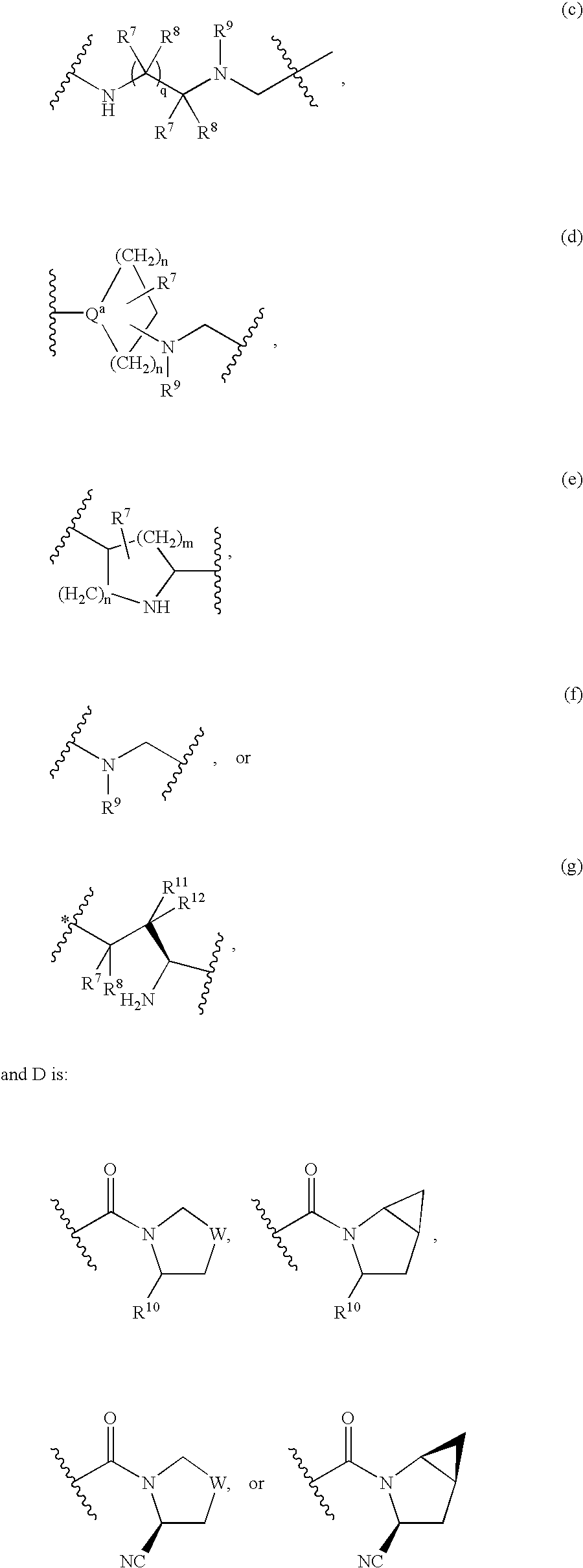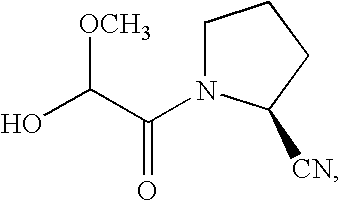Dipeptidyl peptidase-IV inhibitors
a technology of dipeptidyl peptidase and inhibitors, which is applied in the field of pyrrolidine and thiazolidinebased inhibitors of dipeptidyl peptidaseiv, can solve the problems of increased probability of premature morbidity and mortality, ineffective current diabetes treatment options, and limitations
- Summary
- Abstract
- Description
- Claims
- Application Information
AI Technical Summary
Benefits of technology
Problems solved by technology
Method used
Image
Examples
example 2
Preparative Example 2
[0306]
Step A
[0307] Commercially available L-prolinamide (25 g) was dissolved in CH2Cl2 (1200 ml) and triethylamine (30 ml) and 4-dimethylaminopyridine (1.9 g) added. The mixture was cooled to 0° C. and treated with fumaryl chloride (11.7 ml). The dark mixture was stirred at rt for 16 h and cooled to 0° C. TFAA (77 ml) was added dropwise under stirring and the solution allowed to warm to rt over 6 hours. The reaction mixture was stirred at rt for 1 to 2 days. Ice (500 g) was added followed by cautious addition of sat. NaHCO3 (600 ml). After the evolution of gas had ceased, the organic phase was separated and washed with sat. NaHCO3 (350 ml), H2O (350 ml), and brine (200 ml). The organic phase was dried over MgSO4 and concentrated to afford the title compound (28.6 g; 98%).
[0308]1HNMR δ (CDCl3) 2.12-2.30 (m, 8H), 3.58-3.69 (m, 2H), 3.73-3.89 (m, 2H), 4.72-4.83 (m, 2H), 7.26 (s, 2H).
Step B
[0309] The title compound from Step A above (9.6 g) was dissolved in CH...
example 3
Preparative Example 3
[0311]
Step A
[0312] Commercially available 2-cyano-3-methylpyridine (25 g) was dissolved in t-butanol (50 ml) and stirred at 80° C. Concentrated sulphuric acid (25 ml) was slowly added over a period of 45 minutes. After complete addition of the acid stirring was continued at 80° C. for 1 h. The reaction was diluted with water (50 ml) and toluene (125 ml). The pH was adjusted to 10 with 25% aqueous ammonia (110 ml). The separated organic phase was concentrated in vacuum affording the desired product (27 g, 90%).
[0313]1HNMR δ (CDCl3) 1.4 (s, 9H), 2.7 (s, 3H), 7.2-7.3 (m, 1H), 7.6 (m, 1H), 8.1 (s br, 1H), 8.4 (m, 1H)
Step B
[0314] The title compound of Step A (12 g) above was dissolved in THF (150 ml) and cooled to −64° C. n-Butyllithium (1.6 M in hexane, 77 ml) was added over a period of 30 min. After addition of sodium bromide (0.6 g) stirring was continued for 30 min at −64° C. m-Chlorobenzylchloride (11 g) was added while the temperature was kept below −55° ...
example 4
Preparative Example 4
[0323]
Step A
[0324] The title compound from Preparative Example 3 Step E (285 mg) was dissolved in ethanol (10 ml) and 10% Pd / C (100 mg) and ammonium formiate (916 mg) were added. The mixture was refluxed for 2 h. Subsequently, the reaction was treated with water (20 ml) and extracted twice with chloroform (50 ml). The combined organic phase was dried over MgSO4 and concentrated. The residue was purified by chromatography on silica (EtOAc / cyclohexane 1:4) to afford the title compound (200 mg; 82%).
[0325]1HNMR δ (MeOD-d4) 2.9-3.1 (m, 2H), 3.3-3.6 (m, 2H), 6.3 (s, 1H), 7.0-7.3 (m, 4H), 7.4 (m, 1H), 7.8 (m, 1H), 8.3 (m, 1H)
Step B
[0326] The title compound of Step A (200 mg) above was dissolved in toluene (5 ml) and cooled to −15° C. Thionyl chloride (235 mg) was slowly added and the reaction was allowed to come to RT and run overnight. The solution was neutralized with triethylamine directly used.
PUM
 Login to View More
Login to View More Abstract
Description
Claims
Application Information
 Login to View More
Login to View More - Generate Ideas
- Intellectual Property
- Life Sciences
- Materials
- Tech Scout
- Unparalleled Data Quality
- Higher Quality Content
- 60% Fewer Hallucinations
Browse by: Latest US Patents, China's latest patents, Technical Efficacy Thesaurus, Application Domain, Technology Topic, Popular Technical Reports.
© 2025 PatSnap. All rights reserved.Legal|Privacy policy|Modern Slavery Act Transparency Statement|Sitemap|About US| Contact US: help@patsnap.com



